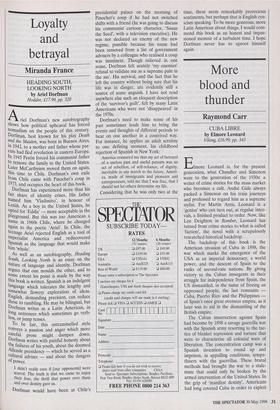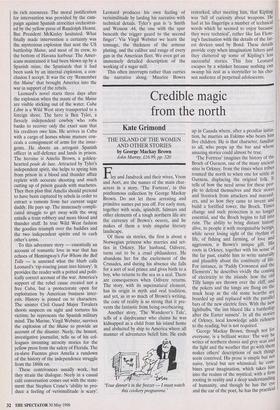More blood and thunder
Raymond Carr
CUBA LIBRE by Elmore Leonard Viking, £16.99, pp. 343 Elmore Leonard is, for the present generation, what Chandler and Simenon were to the generation of the 1930s: a writer of crime stories for the mass market who becomes a cult. Andre Gide always packed a Simenon on his train journeys and professed to regard him as a supreme stylist. For Martin Amis, Leonard is a `genius' who can turn out, at regular inter- vals, a finished product to order. Now, like Len Deighton in Bomber, Leonard has turned from crime stories to what is called `faction', the novel with a scrupulously researched historical backdrop.
The backdrop of this book is the American invasion of Cuba in 1898, the war which marks the emergence of the USA as an imperial democracy, a world power, and the descent of Spain to the ranks of second-rate nations. By giving victory to the Cuban insurgents in their struggle for independence from Spain, the US dismantled, in the name of freeing an oppressed people, the last remnants Cuba, Puerto Rico and the Philippines of Spain's once great overseas empire, as it later was to aid in the dismantling of the British empire.
The Cuban insurrection against Spain had become by 1898 a savage guerrilla war with the Spanish army resorting to the tac- tics of blanket repression and torture that were to characterise all colonial wars of liberation. The concentration camp was a Spanish invention to round up and imprison, in appalling conditions, sympa- thisers with the guerrillas. These brutal methods had brought the war to a stale- mate that could only be broken by the armed intervention of the United States. In the grip of 'manifest destiny', Americans had long coveted Cuba in order to exploit its rich resources. The moral justification for intervention was provided by the cam- paign against Spanish atrocities orchestrat- ed by the yellow press of Randolph Hearst. But President McKinley hesitated. What finally made intervention a certainty was the mysterious explosion that sent the US battleship Maine, and most of its crew, to the bottom of Havana harbour. The Amer- icans maintained it had been blown up by a Spanish mine, the Spaniards that it had been sunk by an internal explosion, a con- clusion I accept. It was the cry 'Remember the Maine' that brought America into the war in support of the rebels.
Leonard's novel starts three days after the explosion when the masts of the Maine are visible sticking out of the water. Cuba Libre is a Wild West story transported to a foreign shore. The hero is Ben Tyler, a fiercely independent cowboy who robs banks to recover only the exact sum that his creditors owe him. He arrives in Cuba with a cargo of horses whose manure con- ceals a consignment of arms for the insur- gents. He shoots an arrogant Spanish officer in self-defence and lands in prison. The heroine is Amelia Brown, a golden- hearted poule de luxe. Attracted by Tyler's independent spirit, she helps to spring him from prison in a blood and thunder affair replete with accurate shooting and much cutting up of prison guards with machetes. They then plan that Amelia should pretend to have been captured by rebels in order to extract a ransom from her current sugar daddy. He pays up. The immensely compli- cated struggle to get away with the swag entails a train robbery and more blood and thunder stuff. In true Wild West fashion the goodies triumph over the baddies and the two independent spirits end in each other's arms.
To this adventure story — essentially an account of romantic love in war that has echoes of Hemingway's For Whom the Bell Tolls — is annexed what the blurb calls Leonard's 'rip-roaring jaunt into history'. It provides the reader with a potted and polit- ically correct account of the war. America's support of the rebel cause created not a free Cuba, but a protectorate open for exploitation by American business inter- ests. History is pinned on to characters. The sinister Civil Guard Major Tavalera shoots suspects on sight and tortures his victims; he represents the Spanish military mind. The Marine, Virgil Webster, survives the explosion of the Maine to provide an account of the disaster. Neely, the honest, investigative journalist, tells us of his col- leagues inventing atrocity stories for the yellow press from the safety of Florida. The ex-slave Fuentes gives Amelia a rundown of the history of the independence struggle from the 1860s on.
These contrivances usually work, but they strain the dialogue. Neely in a casual café conversation comes out with the state- ment that Stephen Crane's 'ability to pro- duce a feeling of verisimilitude is scary'. Leonard produces his own feeling of verisimilitude by larding his narrative with technical details. Tyler's gun is 'a Smith and Wesson .44, the one with the spur beneath the trigger guard to the second finger'. Via Virgil Webster we learn the tonnage, the thickness of the armour plating, and the calibre and range of every gun in the American fleet. We even get an immensely detailed description of the working of a sugar mill.
This often interrupts rather than carries the narrative along. Maurice Bowra remarked, after meeting him, that Kipling was 'full of curiosity about weapons. He had at his fingertips a number of technical words which he seemed to enjoy because they were technical', rather like Ian Flem- ing's fascination with the details of the lat- est devices used by Bond. These details provide copy when imagination falters and they cluttered up some of Kipling's less successful stories. This fate Leonard escapes by a whisker because nothing can swamp his zest as a storyteller to his cho- sen audience of perpetual adolescents.



































































 Previous page
Previous page